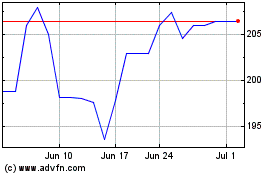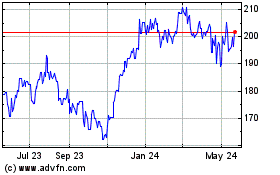By Alexander Osipovich
This article is being republished as part of our daily
reproduction of WSJ.com articles that also appeared in the U.S.
print edition of The Wall Street Journal (April 16, 2018).
Exchange giant CME Group Inc. is facing scrutiny over its
political clout and hardball tactics as a 14-year-old lawsuit nears
trial.
The suit contends that two big Chicago futures exchanges -- now
both part of CME Group -- illegally colluded to prevent a foreign
rival, Eurex, from intruding on their home turf. Eurex's U.S.
exchange filed the suit in October 2003 against the Chicago Board
of Trade and the Chicago Mercantile Exchange. It later revised the
suit to accuse CME and CBOT of manipulating regulators and
politicians to sabotage Eurex's bid.
CME denies the allegations and is making a last-ditch effort to
have the suit thrown out. It says Eurex's U.S. venture -- called
U.S. Futures Exchange and now fully owned by Deutsche Boerse AG --
failed because of its own missteps.
"After more than a decade, this lawsuit is still no substitute
for USFE's lack of a compelling business strategy," a CME
spokeswoman said. "This case is simply USFE's and Eurex's attempt
to shift blame for their own failure."
Rivals have grumbled for years that CME routinely uses its heft
in the markets and influence in Washington to shield itself from
competition. The Eurex case offers a rare glimpse into such
behind-the-scenes maneuvering by the Chicago giant.
It could also reignite complaints that CME engages in
anticompetitive behavior, which the company denies. CME handles the
vast majority of trading in markets such as U.S. stock-index and
interest-rate futures. That is largely because futures are a
winner-take-all business: Once a market is established, it is hard
for a rival to convince traders to switch exchanges.
The case is scheduled to go to trial before a jury in Chicago on
June 4, following years of wrangling over the complex legal issues
at stake.
A trial could result in top CME brass being called to testify,
including Chairman and Chief Executive Terrence Duffy, the
mastermind of a series of deals that turned CME into the world's
largest exchange operator by market capitalization.
CME, which has a market cap of $56 billion, can weather the
costs of the case. If it loses, it could be forced to pay up to
$1.5 billion, based on estimates in court filings that Eurex
suffered $512 million in damages and provisions of antitrust law
that allow it to seek triple that sum.
A trial could dredge up embarrassing details about a long-ago
chapter of CME's history.
Internal documents disclosed in court filings this month shed
light on CME's response to the Eurex threat. In a 2003 memo titled
"CME/CBOT Washington Strategy," two CME lobbyists detailed a plan
to delay the approval of Eurex's U.S. exchange by the Commodity
Futures Trading Commission.
Part of their proposal: enlisting then-House Speaker Dennis
Hastert to add a provision to a spending bill that would have
forced the CFTC to prolong the process.
"This strategy would need to be carried out in an extremely
discrete manner and we believe the only person who can get this
accomplished is Speaker Hastert," says the memo, sent to Mr. Duffy
and other CME executives.
It is unclear whether CME approached Mr. Hastert, who declined
to comment through his lawyer. In the 2002 election cycle, CME's
political-action committee and people affiliated with the company
donated more than $40,000 to Mr. Hastert, a Republican from
Illinois, according to OpenSecrets.org. Mr. Hastert joined CME's
board after leaving Congress and was a member from 2008 to
2015.
Delays in winning CFTC approval caused Eurex to miss a planned
launch in February 2004 by a week. USFE's suit says uncertainties
over the process scared off traders. CME says the delay was
insignificant and that its lobbying activities were appropriate,
focused on issues of market fairness and shouldn't be considered
violations of antitrust law.
The all-electronic Eurex was the world's largest derivatives
exchange by volume in 2003 when it took on Chicago, setting up its
U.S. offices in the Sears Tower. Its plans to launch a suite of
U.S. Treasury futures were a direct threat to CBOT, the dominant
player in that market.
Eurex -- then a joint venture of Deutsche Börse and what is now
called the SIX Swiss Exchange -- had grown rapidly by embracing
technology. Meanwhile, CME and CBOT ran old-fashioned trading
floors alongside computerized platforms and had been criticized for
being slow to adapt to the rise of electronic trading.
But the Chicago exchanges reacted quickly to the threat. CBOT
severed ties with its clearinghouse -- the entity that runs the
financial plumbing for a futures exchange -- and agreed to use
CME's clearinghouse. That undermined Eurex, which hoped to clear
trades through the same clearinghouse as CBOT. Such an arrangement
would have made it easier for traders at CBOT to jump ship for
Eurex.
CBOT also slashed fees days before the Eurex launch. The upstart
exchange floundered and eventually closed in 2008.
The suit also alleges that CME and CBOT intimidated traders seen
as supportive of Eurex. In an April 6 filing, USFE said security at
CBOT's building in Chicago harassed some visitors, telling them
they couldn't enter because they were "working with the
competition." The filing states that a baseball was thrown at
Dennis Dutterer, then-head of CBOT's longtime clearinghouse, as he
was walking in the building.
CME says there is no evidence to support such claims. Mr.
Dutterer, reached for comment by telephone, said he couldn't recall
the baseball incident.
Write to Alexander Osipovich at
alexander.osipovich@dowjones.com
(END) Dow Jones Newswires
April 16, 2018 02:47 ET (06:47 GMT)
Copyright (c) 2018 Dow Jones & Company, Inc.
Deutsche Boerse Ag Namen... (PK) (USOTC:DBOEF)
Historical Stock Chart
From Oct 2024 to Nov 2024

Deutsche Boerse Ag Namen... (PK) (USOTC:DBOEF)
Historical Stock Chart
From Nov 2023 to Nov 2024


